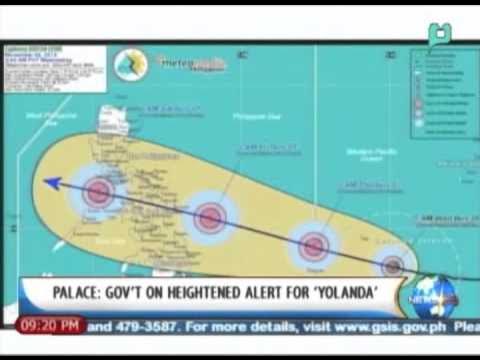Tino Update, Typhoon likely at landfall in Visayas Monday
Summary
TLDRMeteorologist Robert Spen provides an in-depth analysis of Typhoon Tino, also known as Kamigi, which is expected to make landfall in the Philippines between Monday night and Tuesday morning. He details the storm's current trajectory, potential intensification, and the significant risks of storm surges, heavy rainfall, and strong winds, particularly for Samar, Mindanao, and the Visayas. Spen also highlights the uncertainty surrounding its strength and the possibility of another storm following closely behind. He urges viewers to prepare for the worst, emphasizing the importance of safety and preparation amidst such a volatile storm scenario.
Takeaways
- 😀 The typhoon Tino (internationally known as KIG) is expected to make landfall across late-day Samar, Philippines, by Monday night into Tuesday morning.
- 🌪️ Typhoon Tino, which has been tracked for about a week, started as a broad area of convection southeast of Guam, and is now entering the Philippine Area of Responsibility (PAR).
- ⚠️ Areas such as northeastern Mindanao and Samar will experience impacts, particularly in the right front quadrant of the storm, which will bring gusty winds and heavy showers.
- ⏰ The worst weather is expected to affect the east coast of Luzon, Samar, and parts of Cebu as the storm moves overnight into Tuesday morning.
- 🌧️ Typhoon Tino will likely intensify into a storm with winds around 110-120 km/h, but there are concerns that the storm could be stronger than the official forecast suggests.
- 🌀 Models like JTWC predict stronger winds of 120 km/h (about 64 knots), and deep learning models, such as Google DeepMind, suggest the storm could reach Category 4 strength.
- 🚨 The interaction between Tino and the northeast monsoon could lead to storm surge threats, particularly for areas like Tacloban, even if the storm remains weak.
- ⚡ Despite initial disorganization, the storm is tightening up and could rapidly intensify before landfall, a phenomenon often seen in the Philippine Sea effect.
- 🧠 Google DeepMind's model, which learns from previous storm patterns, shows a high likelihood of rapid intensification right before landfall.
- 💡 The meteorologist stresses the importance of preparing for rapid intensification and taking necessary precautions such as evacuation, even for those who have previously experienced storms.
- 🔮 A second storm, possibly forming soon after Tino, is also being monitored. There are concerns it could bring another round of significant impacts within a week.
Q & A
What is the expected landfall timeline for Typhoon Tino?
-Typhoon Tino is expected to make landfall late on Monday night or early Tuesday morning, particularly affecting late-day Samar and northeastern Mindanao.
Which areas are likely to experience the worst impacts from Typhoon Tino?
-The worst weather is expected to be in the right front quadrant of the storm, with gusty conditions and heavy showers affecting the east coast of Luzon, Samar, and even Cebu.
How strong is Typhoon Tino expected to be at landfall?
-The intensity of Typhoon Tino is forecast to be around 110-120 km/h, but the Joint Typhoon Warning Center (JTWC) predicts it could be stronger, reaching 120-130 km/h (64-70 knots).
What concerns are raised about Typhoon Tino's potential for rapid intensification?
-There is concern about the possibility of Typhoon Tino rapidly intensifying just prior to landfall, especially considering historical cases where storms have intensified unexpectedly due to the 'Philippine Sea effect.'
What does the 'Philippine Sea effect' refer to in this context?
-The 'Philippine Sea effect' refers to the phenomenon where tropical storms rapidly intensify as they approach the Philippines, which is difficult for traditional models to predict. It has been observed multiple times with past storms.
What is the significance of the DeepMind model in forecasting Typhoon Tino?
-The DeepMind model, which learns from past storms, has predicted a category 4 storm for Typhoon Tino, indicating that it might intensify quickly before landfall. This model is considered more accurate in predicting rapid intensification compared to traditional numerical models.
How does the northeast monsoon impact Typhoon Tino's path and strength?
-The northeast monsoon is interacting with Typhoon Tino, influencing its track and intensifying the winds, particularly in the northern part of the storm's path. This causes gusty conditions and heavy rainfall even far from the storm’s center.
What is the importance of official weather warnings from PAGASA and JTWC?
-Official warnings from PAGASA (Philippine Atmospheric, Geophysical and Astronomical Services Administration) and JTWC (Joint Typhoon Warning Center) are crucial for accurate, timely updates and safety precautions for affected regions.
What should people do to prepare for Typhoon Tino?
-People should follow official evacuation orders, prepare emergency supplies, and take precautions to protect themselves and their property. It's important to take the storm seriously, even if it seems familiar or manageable.
Is there another storm following Typhoon Tino that could impact the Philippines?
-Yes, there is another potential storm behind Typhoon Tino that could form within the week. The DeepMind model has shown a possible strong storm heading towards southern or central Luzon, but it's still uncertain.
Outlines

此内容仅限付费用户访问。 请升级后访问。
立即升级Mindmap

此内容仅限付费用户访问。 请升级后访问。
立即升级Keywords

此内容仅限付费用户访问。 请升级后访问。
立即升级Highlights

此内容仅限付费用户访问。 请升级后访问。
立即升级Transcripts

此内容仅限付费用户访问。 请升级后访问。
立即升级浏览更多相关视频

Tampa weather | Tracking Hurricane Milton

Bagyong #OfelPH at #PepitoPH, posibleng magsabay sa loob ng PAR ngayong araw | Unang Balita

Bagyong Nika, lalong lumakas at naging tropical storm na | 24 Oras Weekend

[NewsLife] Palace: Gov't on heightened alert for Yolanda || November 6, 2013

Weather update as of 11:05 a.m. (September 19, 2024) | Balitanghali

Bagyong Julian, lumakas pa bilang typhoon | GMA Integrated News Bulletin
5.0 / 5 (0 votes)
